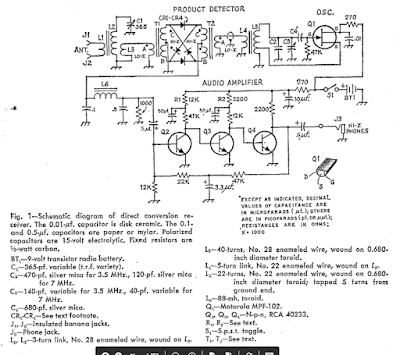Dean KK4DAS's Beautiful DC Receiver
The folks over at Ham Radio Workbench have graciously accepted the challenge issued in our last podcast: that they scratch-build homebrew the 40 meter Direct Conversion receiver that Dean KK4DAS and I designed for local high school students. We want to help our brothers over at HRWB. For example, we may be able to supply a few of the 3D printed PTO coil forms. Here is some background information on the project.
Details on the project can be found here:
----------------------
Design Decisions in the Direct
Conversion Receiver
Why did we do it this way?
In thinking about how to design this receiver, we had to
make early design decisions on almost every stage. Here are some of our key considerations.
VARIABLE FREQUENCY OSCILLATOR:
Normally we might have used a variable capacitor to change
the frequency of this oscillator. But
variable capacitors are now expensive and hard-to-source. Our friend Farhan in Hyderabad used a simple
variable inductor for this purpose in his “Daylight Again” transceiver. The
coil form for this part could be 3D printed.
A metallic screw would vary the inductance as it is screwed in and out
of the coil.
We also decided to use the same simple Colpitts oscillator
circuit used by Farhan in his own high school direct conversion receiver. This circuit is unusual in that the feedback
capacitors are also the frequency determining elements (along with the variable
inductor). This simplified the circuit
and reduced the parts count, and proved to be remarkably stable.
For the VFO buffer we used the simple JFET buffer from
Farhan’s Daylight Again design.
Based on suggestions from other radio amateurs, we developed
a simple frequency readout based on the position of the end of the tuning
screw (how far in or out?).
We selected the 40 Meter band for this receiver because we
thought it would be easier to get the VFO stable on this frequency, and because
Farhan had built his receiver for 40 meters.
MIXER:
At first we hoped to use a simple singly-balanced mixer
using two diodes and a single trifilar transformer. But we found unacceptably high levels of AM
breakthrough (mostly from Radio Marti on 7335 kHz) when using this
circuit. So we switched to a diode
ring. This required two more diodes and
an additional trifilar transformer. We
believed the students would have great difficulty building and installing two
trifilar transformers so early in their building experience. So we used transformers that had been wound
in Hyderabad by a women’s collective employed by Farhan, and developed
a scheme for fool-proof installation of these transformers.
We also found that the mixer needed a diplexer at its output
– this would provide a 50 ohm termination at all frequencies and would result
in much cleaner action by the mixer and greatly reduced AM breakthrough from
Radio Marti. We used the same circuit
used by Roy Lewellen W7EL in his Optimized Transceiver circuit.
BANDPASS FILTER:
This was the simplest board in the project but it required
the students to wind two coils on toroidal cores. A simple dual-tuned circuit design would be
sufficient. We used component values
from the QRP Labs website. We showed
them how to wind the coils, and made a video about the technique. Students used a simple Vector Network
Analyzer (Nano VNA) to tune the filter.
AUDIO AMPLIFIER:
We had to make several design decisions here. First, we rejected the idea of using an IC
amplifier like the ubiquitous LM-386. We wanted this to be a completely analog
and discrete component experience. Then we rejected the idea of using a
push-pull output circuit. While this
would have eliminated the need for an audio output transformer, it would have
resulted in a more complicated circuit. In the end we opted for three simple
RC-coupled common-emitter amplifiers with an audio output transformer. There was no feedback in these circuits. We found there is a lot of gain (hFe)
variation in the 2N3904 transistors that we used. Care needs to be exercised in making sure
that transistors of moderate (but not too high) gain are used.
This AF amplifier chain probably presented a 1500 ohm
impedance to the mixer (instead of the desired 50 ohms), but we think this
problem may have largely been taken care of by the diplexer.
We found some very small (one square inch) speakers that
could be easily used in this circuit.
ANTENNA:
While the students could use a wide variety of antennas, we
recommended a simple ¼ wave antenna with a ¼ wave counterpoise. We thought that this antenna – of only 33
feet in length would provide good performance with low complexity, and would be
well suited to the “upper floor bedrooms” from which many of the students would be listening. Also, this antenna would not require the use
of coaxial cable or an impedance matching transformer. We made a video on how
to build and use this antenna.
POWER SUPPLY:
We opted for the use of 9 volt batteries. This proved to be a safer and wiser choice that
limited the kind of mayhem that could occur should a variable voltage supply be
used.
Details on the receiver can be found here:
https://hackaday.io/project/190327-high-schoolers-build-a-radio-receiver
May 29, 2023









